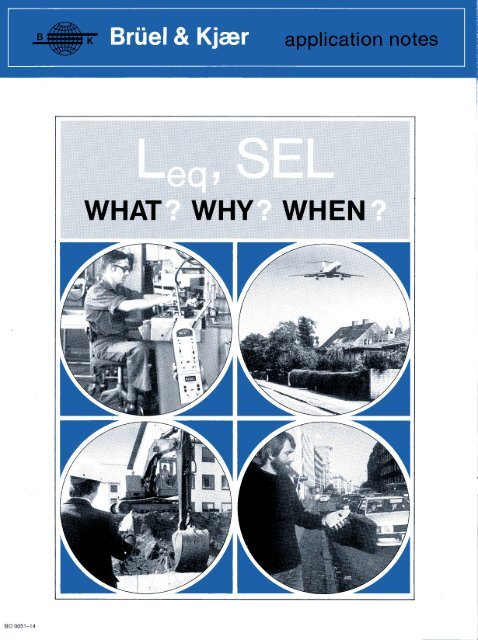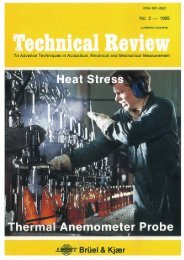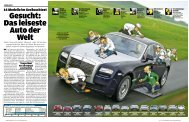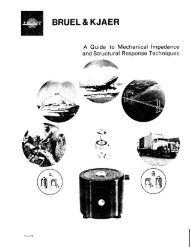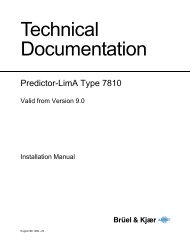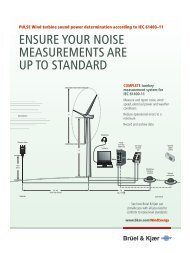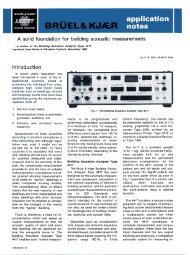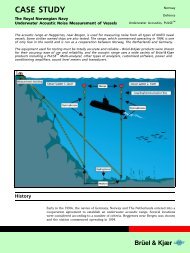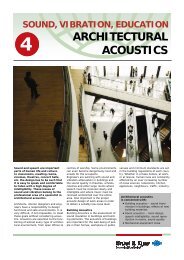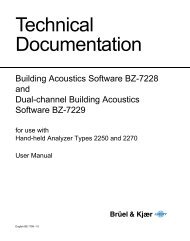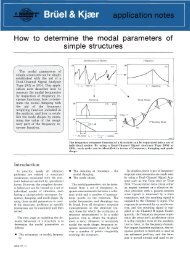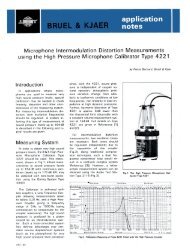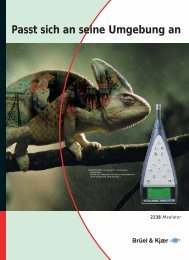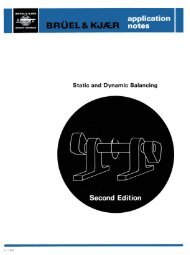Leq, SEL WHAT? WHY? WHEN?
Leq, SEL WHAT? WHY? WHEN?
Leq, SEL WHAT? WHY? WHEN?
- TAGS
- www.bksv.com
Create successful ePaper yourself
Turn your PDF publications into a flip-book with our unique Google optimized e-Paper software.
y Pierre Bernard, Bruel&Kjaer<br />
What are <strong>Leq</strong> and <strong>SEL</strong>?<br />
<strong>Leq</strong>, <strong>SEL</strong><br />
<strong>WHAT</strong>? <strong>WHY</strong>? <strong>WHEN</strong>?<br />
<strong>Leq</strong> and <strong>SEL</strong> are energy param- which has the same amount of ener- Thus, <strong>SEL</strong> is similar to <strong>Leq</strong> in that<br />
eters which provide a very useful gy in one second as the original the total sound energy is integrated<br />
means of describing fluctuating noise event. over the measurement period, but<br />
sounds. In this application note instead of then averaging it over the<br />
we will look at what <strong>Leq</strong> and S E L e n t i r e measurement period, a refer-<br />
are, why we use them and w h e n e n c e duration of 1 s. is used. Sound<br />
we use t h e m . E x p o s u r e Level measurements using<br />
A-weighted sound pressure levels<br />
<strong>Leq</strong> (equivalent continuous s o u n d a r e denoted by the symbol LAE.<br />
level) is defined as the steady sound<br />
pressure level which, over a g i v e n T h e differences between the flue-<br />
period of time, has the same total tuating sound level, the <strong>Leq</strong> and <strong>SEL</strong><br />
energy as the actual fluctuating Fig.2. The definition of <strong>SEL</strong> can be seen in Fig. 3.<br />
noise. Thus, the <strong>Leq</strong> is in fact the<br />
RMS sound level with the measure<br />
ment duration used as the averaging<br />
time.<br />
Fig.t. The definition of <strong>Leq</strong><br />
For most community noise and in<br />
dustrial noise measurements an A-<br />
weighted <strong>Leq</strong> or LAeq is used.<br />
<strong>SEL</strong> or Sound Exposure Level is<br />
defined as that Constant sound level Fig.3. Comparison between <strong>Leq</strong>, <strong>SEL</strong> and time-varying RMS.<br />
2<br />
■
Why use <strong>Leq</strong> and <strong>SEL</strong> ?<br />
<strong>Leq</strong> and <strong>SEL</strong> are used because The response known as "F" (fast) LAeq of either 85dB(A) or 90dB(A)<br />
in many measurement situations gives a steady reading when the over an eight hour working day. Sim-<br />
the widely fluctuating display of a measured sound is steady, if the Marly, environmental noise — for ex-<br />
traditional sound level meter sound level fluctuates, the meter ample, the noise at a construction<br />
makes it extremely difficult to tries to follow the fluctuations. The site or noise due to traffic flow — is<br />
determine the correct sound "F" response is used, for example, also frequently expressed in terms<br />
level. when finding the maximum sound of either an A-weighted <strong>Leq</strong> or <strong>SEL</strong>.<br />
level produced by a motor vehicle in<br />
Traditional sound level meters are a drive-by test. The "S" (slow) re- The traditional sound level meter<br />
designed and built according to in- sponse attempts to steady the read- can only be used to obtain an accu-<br />
ternational (or National) Standards. ings when the noise is of a fluctuat- rate <strong>Leq</strong> if sound levels are steady, or<br />
These Standards define the time ing nature. are steady for relatively long periods<br />
weighting of the sound level meter - of time, so that levels and their dura-<br />
that is the speed with which the de- Regulations governing sound level tions can be noted and recorded,<br />
tector and indicating meter or digital measurements may stipulate the use and an <strong>Leq</strong> calculated.<br />
display respond to sound. of either "F" or "S" time weightings.<br />
Often national legislation and stan- However, if the sound levels flue-<br />
Most sound level measurements dards are based on "A-weighted" tuate too much to allow a meaningful<br />
are RMS values, because of the di- sound energy measurements, for reading Integrating Sound Level Me-<br />
rect relationship between the RMS both industrial and environmental ters should be used. These instru-<br />
value and energy. Thus, a traditional situations. This is normally ex- ments summate noise energy on a<br />
sound level meter displays a time- pressed in terms of an A-weighted relatively long-term basis and divide<br />
varying RMS value using either the <strong>Leq</strong>. For example, in many countries the value obtained by the elapsed<br />
"F" or "S" time weighting. the maximum allowable noise expo- time, thus, providing a direct <strong>Leq</strong><br />
sure for workers is defined as an reading.<br />
When and how do you use <strong>Leq</strong> and <strong>SEL</strong> ?<br />
Let us look at some typical cases be even more difficult if the machine the display of the instrument has sta-<br />
which illustrate when a clearer an- has a complex working cycle (Fig.5). bilized. With cyclical noise, the mea-<br />
swer can be easily obtained by using The reason for the measurement un- surement period should include an<br />
an Integrating Sound Level Meter certainty is that the traditional sound integer number of cycles so that an<br />
which provides data directly in the level meter does not provide time <strong>Leq</strong> measurement effectively repre-<br />
form of either an <strong>Leq</strong> or an <strong>SEL</strong>. constants which are of sufficient du- sents the true average SPL, having<br />
ration. However, this can be over- the same energy as the fluctuating<br />
1. <strong>Leq</strong> measurements come by measuring the overall ener- sound.<br />
gy of the noise.<br />
Fluctuating machinery noise Long-term noise exposure<br />
Fig.4 shows a recording of the When measuring <strong>Leq</strong> the choice of It is often necessary to rate noise<br />
noise produced by a typewriter. measurement duration depends on on a long-term basis. In industry,<br />
Even with the "S" time-weighting, the type of noise. For relatively workers' exposure to noise during<br />
the fluctuations make it difficult to steady noises such as machinery work is assessed to establish it's ac-<br />
put a value on the noise level. It can noise the reading can be taken when ceptability. In towns and dwellings,<br />
Fig.4. Typical recording of typewriter noise Fig.5. The noise produced by a machine with different cycles may vary considerably<br />
using the "S" time-weighting<br />
3<br />
■<br />
1
environmental noise produced by<br />
traffic, industry, etc. is measured to<br />
estimate annoyance caused by noise<br />
and thereby the degree of communi<br />
ty reaction to be expected. In both<br />
cases, noise may vary considerably<br />
over the exposure period. Record<br />
ings of a time-varying RMS (as<br />
shown in Figs.6 and 7) do not allow<br />
either direct comparison or simple _. e _ . . a .. . .M . an ...<br />
r ^ Fig.6. Typical recording of noise in an office<br />
rating of noise exposure. In such<br />
cases, the data analysis provided by<br />
traditional sound level meters is not<br />
sufficient.<br />
<strong>Leq</strong> measurements for long-term<br />
exposure rating, require the selec<br />
tion of representative measurement<br />
periods. In the case of occupational<br />
noise exposure, this may be a whole<br />
working day, or alternatively parts of<br />
the day in which representative mea<br />
surements of the entire working day<br />
can be made.<br />
Similarly, community noise expo<br />
sure can be assessed by measure<br />
ment of <strong>Leq</strong> over a whole day, or by<br />
taking "period" <strong>Leq</strong> measurements of<br />
representative intervals within typi<br />
cal periods (e.g. quiet periods during<br />
daytime, rush hours, evening, night).<br />
2. <strong>SEL</strong> measurements Fig.7. Typical recording of traffic noise a) in a busy street and b) close to a motorway<br />
Transient noise<br />
As seen in the above examples,<br />
<strong>Leq</strong> measurements give us very use<br />
ful results in many situations. How<br />
ever, an <strong>Leq</strong> measurement does not<br />
remove ambiguity in the case of<br />
transient noise, for example from an<br />
aircraft fly-over or a vehicle drive-by<br />
(Figs.8 & 9). These situations often<br />
result in wide variations from back<br />
ground noise to maximum level and<br />
if only the maximum level is report<br />
ed, information on the duration of<br />
the noise (an important feature for<br />
rating annoyance) is lost. This also<br />
makes it difficult to compare be<br />
tween rapid and slow events, and to<br />
combine different events for noise Fi 9- 8 - Typical recording of aircraft fly-over noise<br />
prediction purposes.<br />
Since <strong>Leq</strong> is an energy average, In such a case, use of an Sound <strong>SEL</strong> is therefore numerically<br />
only the highest levels (from the Exposure Level (<strong>SEL</strong>) eliminates the equivalent to the total sound energy,<br />
maximum to, say, 15 to 20dB below influence of the measurement dura- whereas <strong>Leq</strong> is proportional to the<br />
it) contribute significantly to the total tion. Although the total sound energy average sound power.<br />
energy. Hence, if a measurement be- is integrated over the measurement<br />
gins and ends in the background period — as with <strong>Leq</strong> — instead of <strong>SEL</strong> has two main applications.<br />
noise, the resulting <strong>Leq</strong> will depend then averaging this over the mea- The first is direct comparison of<br />
on the measurement period, even surement period, a reference dura- transient noises. Fig.9 shows two<br />
though the total energy is the same. tion of 1 s is used. drive-by noises recorded on the<br />
4
same time scale. Although the differ<br />
ence between the maximum levels is<br />
approximately 16dB, the difference<br />
between the <strong>SEL</strong> values is only<br />
12dB, indicating that the low level<br />
event lasts longer. This example<br />
shows that measurement of only the<br />
maximum noise level is an insuffi<br />
cient description of a transient<br />
noise.<br />
The second application of <strong>SEL</strong> is<br />
to calculate the corresponding <strong>Leq</strong><br />
for a given period using the individ<br />
ual <strong>SEL</strong> values for different events<br />
occurring within that period. For just<br />
one event occuring during the time<br />
interval T, the relationship between<br />
<strong>SEL</strong> and <strong>Leq</strong> over this time interval T<br />
is:<br />
<strong>Leq</strong> = <strong>SEL</strong> - 10 log — with T0 = 1 s<br />
To<br />
If there are several events with dif<br />
ferent individual <strong>SEL</strong> values, the ex<br />
posure levels can be added on an<br />
energy basis as shown below:<br />
n <strong>SEL</strong>j j<br />
<strong>Leq</strong> = 10 log ^T 10~^-10log<br />
j = 1 T0 Fig.9. Comparison of transient noises<br />
The <strong>SEL</strong> values may for example<br />
be those from different types of ve<br />
hicles. They may also be from differ<br />
ent types of machines performing<br />
cyclical operations provided that the<br />
number of cycles is known for the<br />
exposure period. For such cyclical<br />
noises, measurements of <strong>SEL</strong> should<br />
start and end in the quieter part of<br />
the cycle ensuring that the noise en<br />
ergy in a whole cycle is measured.<br />
The Integrating Sound Level Meter<br />
The integrating sound level meter in our homes, which is in fact an<br />
consists basically of a microphone integrating wattmeter. It does not<br />
with it's preamplifier, an A-weighting provide a record of our instanta-<br />
filter and an integrator which sum- neous consumption; we just read it<br />
mates the noise energy over the from time to time to know how much<br />
measurement period. The measured energy we have consumed since the<br />
result may be expressed in two last inspection. The bill does not de-<br />
ways, depending on the type of pend on how the electricity was<br />
noise; either as an Equivalent Con- used, but on the total amount of en-<br />
tinuous Sound Level (<strong>Leq</strong>), or a ergy consumed, which is numerically<br />
Sound Exposure Level (<strong>SEL</strong>). equivalent to <strong>SEL</strong>. If we divide the<br />
total energy by the corrersponding<br />
The operating principle of inte- time period, we obtain the average<br />
grating sound level meters is quite power consumption, which corre-<br />
similar to that of the electricity meter sponds to <strong>Leq</strong>.<br />
Fig.10. Example of <strong>Leq</strong> derivation from <strong>SEL</strong> values<br />
5
The B&K Family of Integrating Sound Level Meters<br />
Integrating Sound Level M e t e r s A microprocessor ensures the cal-<br />
Types 2225 and 2 2 2 6 c u l a t i o n of the true <strong>Leq</strong> or <strong>SEL</strong> values<br />
These pocket-size sound level m e - a n d it is possible to switch between<br />
ters (Fig.11) conform to IEC 6 5 1 t h e two calculations during the mea-<br />
Type 2 (except for "Max. Hold" f o r s u r e m e n t . The results are presented<br />
2225) and ANSI S.1.4-1983. Both m e - o n a large digital display with a reso-<br />
ters display the A-weighted s o u n d l u t i o n of 0,1 dB. The display also has<br />
pressure level on a 40dB column d i s - s y m b o l s for indicating overload, un-<br />
play and have a total measurement der range, battery state, time ex-<br />
range from 25 to 140dB(A). As well Fjg 12 Example of 60s <strong>Leq</strong> recording over a ceeded (<strong>Leq</strong> measurement) and A- or<br />
as the traditional "F" and "S" time 2 hour period Linear weighting. Although the maxi-<br />
constants, the 2225 provides a mum measurement period for <strong>Leq</strong> is<br />
"Peak Hold" and the 2226 an "I" 2,77 hours, the equivalent level for<br />
mode (a hold function is available on of the event and the final 60s <strong>Leq</strong> longer periods can be derived from<br />
all modes on the 2226). Both meters value can be converted to the corre- the <strong>SEL</strong> value.<br />
have an integrating mode with a sponding <strong>SEL</strong> by addition of 10 log<br />
fixed measurement period of 1 min- 60 (approximately 18dB). The instruments are automatically<br />
ute, providing an A-weighted 60s. reset when changing the measure-<br />
Uq (LAeq)- During the integration pro- Precision Integrating Sound Level ment range or the function selector<br />
cess, the display keeps flashing until Meters Type 2221 and 2222 (except between <strong>Leq</strong> and <strong>SEL</strong>). A<br />
the averaging period is over. The re- As light and slim as Types 2225 pause function allows the exclusion<br />
suiting 60s <strong>Leq</strong> value is then held un- and 2226, the Precision Integrating of unwanted events in <strong>Leq</strong> and <strong>SEL</strong><br />
til the instrument is reset. If the DC Sound Level Meters Types 2221 and measurements and makes it possi-<br />
output of the sound level meter is 2222 (Fig.13) conform to IEC 651, ble to use the instruments for spatial<br />
connected to a level recorder such Type 1, and to the proposed IEC averaging in sound power measure-<br />
as Type 2317, the sound level meter standard for integrating sound level ments. The signal available at the AC<br />
is automatically reset at the end of meters Type 1P. output is either A or linear-weighted,<br />
each integration period, enabling the depending on the function selected.<br />
recording of a series of consecutive They have four basic measure-<br />
60s <strong>Leq</strong> values (Fig.12). ment modes: an A-weighted <strong>Leq</strong> Precision Integrating Sound Level<br />
(LAeq), A-weighted <strong>SEL</strong> (LAE), Max. Meter Type 2230<br />
Type 2225 or 2226 may also be Hold "F" (2221) or "S" (2222), and Type 2230 (Fig.14) is a Type 1 pre-<br />
used to calculate the <strong>SEL</strong> of events Max. Hold "Peak". The three first cision instrument. Its comprehensive<br />
which last for less than 1 minute. The functions are A-weighted, whilst the construction and versatility make it<br />
instrument is reset at the beginning "Peak" value is measured with a flat ideal for all kinds of sound level<br />
frequency response. Four overlap- measurements. This includes octave<br />
ping sensitivity ranges provide a and 1 /3 octave frequency analysis<br />
measurement span from 25dB to when used with a snap-on filter set.<br />
145dB for <strong>Leq</strong> measurements.<br />
The Type 2230 has a measurement<br />
range from 24 to 130 dB (30 to 150 dB<br />
with supplied attenuator) and carries<br />
out five measurements in parallel:<br />
SPL, Max., Min., <strong>Leq</strong> and <strong>SEL</strong>, all of<br />
which can be obtained for the same<br />
signal. A choice between 2 detector<br />
modes (RMS and Peak), 3 time<br />
weightings ("S", "F", "I"), 4 frequen<br />
cy weightings (A, C, Lin and All pass)<br />
is available for the measurements.<br />
A partial (Max./Min.) reset, a total<br />
reset and a pause function increase<br />
the capabilities of the instrument.<br />
The linear free field frequency re<br />
sponse (in accordance with IEC) can<br />
also be switched to a linear diffuse<br />
field frequency response to comply<br />
with ANSI requirements.<br />
The measurements are displayed<br />
Fig.11. The Integrating Sound Level Meters Fig.13. Precision Integrating Sound Level „ J ,_ , ,.<br />
Types 2225 and 2226 Meter Type 2222 W l t h a °' 1 d B resolution On a large 4<br />
6
tions on the front panel of the 2231<br />
are defined by the software<br />
package.<br />
This flexibility, together with provi<br />
sions for connecting Fitter Sets and<br />
hard-copy recorders, enable the<br />
2231 to be used for a wide variety of<br />
noise measurements.<br />
The 2231 fulfils IEC and ANSI Type<br />
1 SLM requirements and also the<br />
proposed integrating SLM require<br />
ments. A unique parallel-detector al<br />
lows display of both RMS and Peak<br />
values of the same signal. "A", "C",<br />
"Lin." (10Hz to 20kHz) and "All<br />
Pass" (2 Hz to 70 kHz) frequency<br />
weightings are available. The DC<br />
output allows recording of "module-<br />
defined" parameters. Five of the ap-<br />
Fig.14. The Precision Integrating Sound Level plication modules are described Fig.15. The Modular Precision Sound Level<br />
Meter Type 2230 below* Meter Type 2231 and one of its application<br />
modules<br />
digit liquid crystal display. The SPL Integrating SLM Module BZ7100:<br />
is continuously monitored on a qua- Standard module delivered with the vice such as a data-logger, micro-<br />
si-analogue 60dB scale. Indication 2231. "F", "S" and "I" time respons- processor or printer. Time and fre-<br />
of overload, depleted batteries and es and 4 frequency weightings. Mea- quency weightings as for BZ7100.<br />
illegal setting is also displayed. surement Parameters: Max. peak Simultaneous measurement at one<br />
hold; Max. peak in 1 s period; Sam- second intervals of max. SPL, in-<br />
AC and DC outputs allow tape or pled RMS in 1 s; Max. RMS in 1 s; stantaneous SPL and Peak, and at<br />
level recordings to be made and au- Max. SPL hold; Min. SPL hold; <strong>Leq</strong> user selectable intervals <strong>Leq</strong>, <strong>SEL</strong>,<br />
dio monitoring of the sound level (Llm with "I" response); <strong>SEL</strong> (IEL min. SPL, max. SPL and max. Peak.<br />
with the selected frequency with "I" response). Special Func-<br />
weighting. tions: setting quasi-analogue scale Event Recording Module BZ 7107:<br />
to display peak levels; DC output Enables the 2231 to measure and re-<br />
Despite its Type 1 performance giving <strong>Leq</strong> vs. time histogram; data- cord the principle parameters con-<br />
and the numerous functions includ- inhibit using pause pushkey; digital nected with a noise event. An event<br />
ed, the Type 2230 is only 25cm long readout facility. is taken to exist when the the ambi-<br />
and weighs less than 1 kg. It can eas- ent noise level exceeds a predefined<br />
ily be held in one hand, even when Statistical Analysis Module threshold level for more than a pre-<br />
the Filter Set is connected. BZ7101: "F" and "S" time responses defined time. The principle parame-<br />
and 4 frequency weightings. Mea- ters, i.e. <strong>Leq</strong>, <strong>SEL</strong>, max. and min.<br />
Types 2233 and 2234 are special surement Parameters: as for BZ7100 SPL, duration and threshold level to-<br />
versions of the 2230. Type 2233 has plus L(99.0), L(90.0), L(50.0), L(10.0) gether with other data may be trans-<br />
the same functions (except Min. and L(1.0). Also calculates LN, Cumu- ferred digitally to a data-logger or<br />
measurement), but also incorporates lative and Probability Distributions printer. Time and frequency weight-<br />
facilities to measure "Taktmaximal- with 0,5dB resolution for any mea- ings as for BZ7100.<br />
pegel"*. Type 2234 has the same surement period. Special functions:<br />
functions as 2230, but the SPL dis- LN for values of N in 0,1% steps; vari- Graphic Documentation Printer<br />
played is the instantaneous value able resolution for Cumulative and Type 2318<br />
sampled every second and not the Level Distributions; data-inhibit The 2318 is small, lightweight, bat-<br />
maximum in the previous second. facility. tery operated and can be used to<br />
make printed and graphic record-<br />
Modular Precision Sound Level "Taktmaximal"* Module BZ7102: ings of measurements when con-<br />
Meter Type 2231 Time and frequency weightings as nected to any instrument with a<br />
The Type 2231 (Fig.15) is a truly ver- for BZ7100. Provides the 2231 with B & K serial interface and nearly all<br />
satile precision sound level meter. special facilities for measuring other RS 232C and RS 232C based<br />
Application modules are used to "Taktmaximalpegel"*. systems. It is particularly well suited<br />
adapt the capabilities of the 2231 to for use with the Modular Precision<br />
suit the requirements for a particular Short Term <strong>Leq</strong> Module BZ 7106: Sound Level Meter Type 2231 and all<br />
measurement. The pushkeys func- Enables the 2231 to transfer data of its application modules for docu-<br />
digitally at user selectable intervals menting measurements and other al-<br />
* an energy averaging technique specified in (minimum 1 s) with a choice of 64 lied data in clear and readable<br />
DIN 45645 possible formats to an external de- formats.<br />
7
Noise Level Analyzer Type 4427<br />
The Noise Level Analyzer Type 4427<br />
(Fig.16) offers a wide range of fea<br />
tures for accurate on-site analysis of<br />
community, airport and traffic noise<br />
or any other acoustical event requir<br />
ing accurate measurements and ex<br />
tensive statistical analysis of collect<br />
ed data.<br />
The Type 4427 Noise Level Analyz<br />
er represents an innovative design<br />
concept, complying with the relevant<br />
sections of IEC 651 and ANSI<br />
S 1,4 (1983) Sound Level Meter<br />
Specification Type 0. It permits fast,<br />
,,y - ,v " •«-—"— « «-—!«» .,P-<br />
user-friendly dialogue selection o f T h i s means in practice that, for a<br />
instrument settings and p r o v i d e s g i v e n noise dose, the exposure dura-<br />
data collection, storage, level a n a l y - t i o n should be halved if the sound<br />
sis and print-out in one c o m p a c t p r e s s u r e level increases by 3dB. A<br />
unit. Time-saving menu-driven p r o - d i f f e r e n t trading relationship be-<br />
cedures allow easy interactive i n - t w e e n sound level and exposure du-<br />
strument set-up, reducing the n e e d r a t i o n is specified by the American<br />
for instruction manuals. S o p h i s t i c a t - O S H A , whereby the exposure dura-<br />
ed dataprocessing facilities i n c o r p o - t i o n is halved for a 5dB increase.<br />
rated in the 4427 allow c o m p r e h e n - T y p e 4434 is designed to satisfy the<br />
sive front-end processing of s i g n a l O S H A requirements.<br />
data.<br />
Summary<br />
The detector circuit provides F, S , I n t e g r a t i n g sound level meters can<br />
I and Peak plus 3 s and 5 s T a k t - b e used to solve a number of noise<br />
Maximalpegel responses in parallel measurement problems which would<br />
with True Linear 1 s <strong>Leq</strong> responses. A Fig.17. The Noise Dose Meter Type 4428 be extremely difficult to handle with<br />
built-in IEC/IEEE or optional RS- traditional sound level meters. Much<br />
232 C communication interface port sound level meters which have been noise legislation is based on <strong>Leq</strong><br />
provides for remote set-up and con- especially designed to monitor the measurements, both for industrial<br />
trol with the same ease as operating noise exposure of workers during a noise exposure in the workplace and<br />
the frontpanel keypad. working day. The digital display indi- noise annoyance in communities.<br />
cates the Noise Dose, which gives Several international standards also<br />
The 110 dB dynamic range of the the noise exposure as a percentage recommend <strong>Leq</strong> and <strong>SEL</strong> as basic<br />
detector ensures that no information of the maximum allowable exposure noise descriptions, for example:<br />
from the input signal is lost, and a (which, in most countries, corre-<br />
wide range of levels can be mea- sponds to an LAeq of either 85 or ISO 1996: "Assessment of noise with<br />
sured with extreme accuracy. A 90dB(A) for an 8 hour working day). . respect to community re-<br />
built-in graphic printer/plotter allows Conversion tables enable derivation sponse"<br />
fully annotated permanent records of LAeq from the noise dose reading ISO 1999: "Assessment of occupa-<br />
to be made on metallised paper. and the measurement duration. An tional noise exposure for<br />
accelerated mode is provided for hearing conservation pur-<br />
Powered by batteries, the Noise calibration and short-term surveys. poses"<br />
Level Analyzer offers this unique A peak detector is included to indi- ISO 3891: "Description of aircraft<br />
combination of features in a com- cate whether the maximum of noise heard on the<br />
pact unit ideally suited for field 140dB(A) peak has been exceeded ground"<br />
operation. during the measurements.<br />
The wide range of B&K Integrat-<br />
Noise Dose Meters Types 4428 and Type 4428 integrates the noise en- ing Sound Level Meters enables se-<br />
4434 ergy according to the definition of lection of the instrument which best<br />
The Noise Dose Meter Types 4428 LAeq, as required by ISO 1999 and the meets the specific requirements of a<br />
and 4434 (Fig.17) are integrating legislation of different countries. given noise measurement situation.


